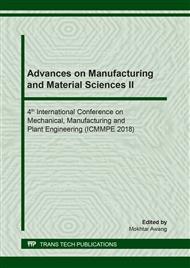[1]
Stephen Malkin, Changsheng Guo, Grinding technology - Theory and Applications of Machining with Abrasives, Industrial Press (the second edition), (2008).
Google Scholar
[2]
Snoeys, R., Maris, M., and Peters, J., Thermally induced damage in grinding, Annals of the C.I.R.P., 1978, II, pp.571-581.
Google Scholar
[3]
Shaw, M.C., Principles of abrasive processing, 1996, Oxford University Press.
Google Scholar
[4]
J.A. Badger, A. Torrance, Burn awareness, Cutting Tool Engineering, 52 (12) (2000).
Google Scholar
[5]
W.B. Rowe, D.F. McCormack, T. Jin, Controlling the surface integrity of ground components, Abrasives (DEC/JA) 2001; 24–30.
Google Scholar
[6]
X. Chen, W.B. Rowe, D.F. McCormack, Analysis of the transitional temperature for tensile residual stress in grinding, Journal of Materials Processing Technology 107 (1–3) (2000) 216–221.
DOI: 10.1016/s0924-0136(00)00692-0
Google Scholar
[7]
O. Desa, S. Bahadur, Material removal and subsurface damage studies in dry and lubricated single-point scratch tests on alumina and silicon nitride, Wear 225–229 (II) (1999) 1264–1275.
DOI: 10.1016/s0043-1648(99)00048-4
Google Scholar
[8]
Tawakoli, T., Minimum coolant lubrication in grinding, Industrial Diamond Review, 2003, pp.60-65.
Google Scholar
[9]
Bell, D.D., Chou, J., and Liang, S., Modeling of the environmental effect of cutting fluid, Tribology Transactions, 1999, 42(1), pp.168-173.
DOI: 10.1080/10402009908982204
Google Scholar
[10]
Cheng, Z., Wong, K., Li, W., Liang, S., and Stephenson, D.A., Cutting fluid aerosol generation due to spin-off in turning operation: Analysis for environmentally conscious machining, Journal of Manufacturing Science and Engineering, Transactions of the ASME, 2001, 123, pp.506-512.
DOI: 10.1115/1.1367268
Google Scholar
[11]
Yue, Y., Sutherland, J.W., and Olson, W.W., Cutting fluid mist formation in machining via atomization mechanisms, in Proceedings of the 1996 ASME International Mechanical Engineering Congress and Exposition, 1996, Atlanta, GA, USA, pp.37-46.
Google Scholar
[12]
K.Q. Xiao, L.C. Zhang, The effect of compressed cold air and vegetable oil on the subsurface residual stress of ground tool steel, Journal of Materials Processing Technology 178, 2006, p.9–13.
DOI: 10.1016/j.jmatprotec.2005.05.013
Google Scholar
[13]
H.Z. Choi, S.W. Lee, H.D. Jeong, A comparison of the cooling effects of compressed cold air and coolant for cylindrical grinding with a CBN wheel, Journal of Materials Processing Technology 111 (2001), pp.265-268, Elsevier Science B.V., (2001).
DOI: 10.1016/s0924-0136(01)00531-3
Google Scholar
[14]
Rodrigo Daun Monici, Eduardo Carlos Bianchi, Rodrigo Eduardo Catai, Paulo Roberto de Aquiar, Analysis of the different forms of application and types of cutting fluid used in plunge cylindrical grinding using conventional and superabrasive CBN grinding wheels, International Journal of Machine Tools & Manufacture 46 (2006), pp.122-131, Elsevier Ltd, (2006).
DOI: 10.1016/j.ijmachtools.2005.05.009
Google Scholar
[15]
Salete Martins Alves, João Fernando Gomes de Oviveira, Development of new cutting fluid for grinding process adjusting mechanical performance and invironmental impact, Journal of Materials Processing Technology 179 (2006), pp.185-189, Elsevier B.V., (2006).
DOI: 10.1016/j.jmatprotec.2006.03.090
Google Scholar
[16]
K. Ramesh, H. Huang, L. Yin, Analytical and experimental investigation of coolant velocity in high speed grinding, International Journal of Machine Tools & Manufacture 44, 2004, p.1069–1076. Elsevier Ltd, (2004).
DOI: 10.1016/j.ijmachtools.2004.02.017
Google Scholar
[17]
Bijoy Mandal, Rajender Singh, Santanu Das, Simul Banerjee, Improving grinding performance by controlling air flow around a grinding wheel, International Journal of Machine Tools & Manufacture 51, 2011, p.670–676.
DOI: 10.1016/j.ijmachtools.2011.06.003
Google Scholar


